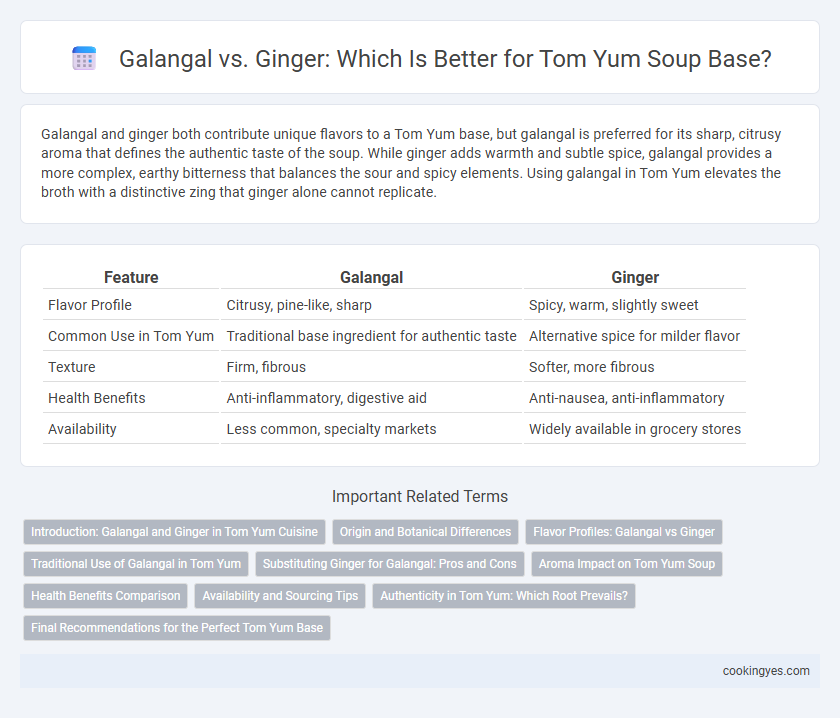Galangal and ginger both contribute unique flavors to a Tom Yum base, but galangal is preferred for its sharp, citrusy aroma that defines the authentic taste of the soup. While ginger adds warmth and subtle spice, galangal provides a more complex, earthy bitterness that balances the sour and spicy elements. Using galangal in Tom Yum elevates the broth with a distinctive zing that ginger alone cannot replicate.
Table of Comparison
| Feature | Galangal | Ginger |
|---|---|---|
| Flavor Profile | Citrusy, pine-like, sharp | Spicy, warm, slightly sweet |
| Common Use in Tom Yum | Traditional base ingredient for authentic taste | Alternative spice for milder flavor |
| Texture | Firm, fibrous | Softer, more fibrous |
| Health Benefits | Anti-inflammatory, digestive aid | Anti-nausea, anti-inflammatory |
| Availability | Less common, specialty markets | Widely available in grocery stores |
Introduction: Galangal and Ginger in Tom Yum Cuisine
Galangal and ginger are essential roots used in Tom Yum, each imparting distinct flavors to the traditional Thai soup. Galangal offers a sharp, citrusy aroma with a hint of pine, creating the authentic Tom Yum base, while ginger provides a milder, spicier warmth. Using galangal preserves the classic taste profile, whereas ginger can slightly alter the soup's aromatic balance and heat level.
Origin and Botanical Differences
Galangal, native to Southeast Asia, particularly Thailand and Indonesia, is a rhizome from the Zingiberaceae family with a tougher texture and citrusy, pine-like flavor distinct from ginger. Ginger, originating in South Asia, belongs to the same family but features a softer texture and a warm, spicy taste, making it less pungent than galangal in Tom yum broths. The unique botanical structures, including galangal's shiny, reddish skin and fibrous interior versus ginger's pale, knobby appearance, contribute to the characteristic aroma and flavor profile essential for authentic Tom yum.
Flavor Profiles: Galangal vs Ginger
Galangal offers a sharp, citrusy, and slightly piney flavor that creates the distinctive aromatic base essential for authentic Tom yum soup, while ginger presents a warmer, earthier, and mildly sweet taste that can mellow the broth. The bright and pungent notes of galangal enhance the soup's complexity, balancing the sour and spicy elements more effectively than ginger's softer, spicier warmth. Chefs prefer galangal in traditional Tom yum recipes for its bold, zesty flavor that defines the soup's unique character compared to ginger's more familiar and subtler profile.
Traditional Use of Galangal in Tom Yum
Galangal, a key ingredient in traditional Tom Yum, imparts a distinctive citrusy and pine-like aroma that ginger cannot replicate, preserving the authentic flavor profile of this classic Thai soup. Unlike ginger, galangal's firm texture and unique medicinal properties have been valued in Thai cuisine for centuries, particularly in balancing the spicy and sour elements of Tom Yum. Using galangal in the broth enhances the soup's depth and closely aligns with the traditional preparation methods passed down through generations.
Substituting Ginger for Galangal: Pros and Cons
Substituting ginger for galangal in Tom Yum base alters the flavor profile significantly, as galangal imparts a sharp, citrusy, and pine-like aroma essential to authentic Thai cuisine, while ginger offers a milder, sweeter, and earthier taste. Using ginger can be advantageous when galangal is unavailable, providing a familiar warmth that complements the broth, but it may lack the distinctive pungency required for traditional Tom Yum's signature complexity. However, relying on ginger risks compromising the balance of flavors, potentially leading to a less vibrant and less aromatic soup.
Aroma Impact on Tom Yum Soup
Galangal imparts a sharp, citrusy aroma with subtle pine notes that intensify the authentic fragrance of Tom Yum soup, enhancing its signature bright and tangy profile. Ginger offers a warmer, earthier scent that softens the soup's bold flavors, resulting in a milder aromatic complexity. Using galangal emphasizes the traditional, vibrant aroma essential to Tom Yum, while ginger introduces a gentler, less pronounced fragrance.
Health Benefits Comparison
Galangal and ginger both enhance Tom Yum's flavor while offering distinct health benefits; galangal contains anti-inflammatory compounds and antioxidants that support digestion and immune health, whereas ginger is renowned for its potent anti-nausea and digestive properties. Galangal's essential oils help reduce pain and bacterial infections, making it effective for treating respiratory issues and skin conditions. Ginger's gingerol content acts as a strong antioxidant, aiding in reducing muscle pain and combating chronic inflammation, complementing the therapeutic profile of Tom Yum soup.
Availability and Sourcing Tips
Galangal is a crucial ingredient for authentic Tom Yum, but it can be harder to find in regular grocery stores compared to ginger, which is more widely available and often used as a substitute. For the best flavor, source fresh galangal from Asian or specialty markets, or consider frozen galangal as a convenient alternative when fresh is unavailable. When sourcing, look for firm, unblemished rhizomes with a spicy, citrus aroma to ensure quality and authenticity in your Tom Yum base.
Authenticity in Tom Yum: Which Root Prevails?
Galangal prevails over ginger in authentic Tom Yum base due to its unique citrusy and pine-like aroma that defines the soup's signature flavor profile. While ginger offers warmth and subtle spice, galangal's sharp, earthy notes are essential for maintaining the traditional Thai culinary integrity. Using galangal ensures an authentic Tom Yum experience, preserving the dish's original balance of sour, spicy, and aromatic elements.
Final Recommendations for the Perfect Tom Yum Base
Galangal offers a sharper, more citrusy flavor essential for an authentic Tom Yum base, while ginger provides a milder, warmer taste that can soften the broth's intensity. For the perfect Tom Yum base, prioritize fresh galangal to achieve the traditional balance of spicy and sour notes central to the dish's identity. Incorporate ginger sparingly if a subtler warmth is desired, but never at the expense of galangal's distinctive aromatic punch.
Galangal vs Ginger for Tom yum base Infographic

 cookingyes.com
cookingyes.com